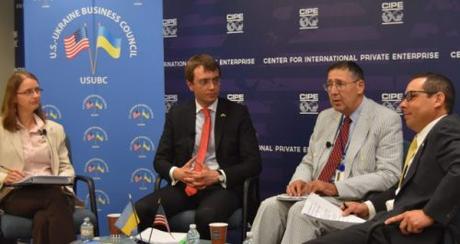
panelists from Identifying and Removing Barriers to Investment in Ukraine
By Eric Hontz and Kathryn Walson
Three years after Ukraine’s Revolution of Dignity, a centralized, oligarchic power structure has once again taken hold. This has made it challenging to keep the business environment in Ukraine friendly to western investment, as the new power structure allows for increased influence from oligarchs and leads to increased corruption. Further, ongoing hostility with Russia and corruption act as a serious deterrent for western investors, which bring with them demands for higher standards in compliance, governance, and accountability from government institutions.
Because public funding alone cannot solve the country’s infrastructure problems, foreign investment into Ukrainian infrastructure is essential to the country’s ability to increase exports and gross domestic product. Despite this paradox in expectations and reality, an increase in investment in Ukraine has already begun, as Ukraine has consciously turned its efforts towards recruiting western businesses. CIPE and the U.S.-Ukraine Business Council co-hosted a panel discussion in June to discuss the investment climate in Ukraine, featuring Volodymr Omelyan, Minister of Infrastructure in Ukraine; former Ambassador John E. Herbst, current Director of the Dinu Patriciu Eurasia Center at the Atlantic Council; and Matt London, Deputy Managing Director at Amsted Rail Russia-CIS at Amsted Rail Inc.
Herbst cited war and corruption as ongoing deterrents for investors, adding that it could take perhaps 20 or 30 years for the country to thrive. Currently, Russian-supported militias occupy about seven percent of the country, and aim to “destabilize the government by imposing economic costs and killing Ukrainians, both soldiers and civilians,” he said. “Countries at war don’t attract a great deal of investment. Investors like peace.”
Another major problem is Ukraine’s rail system, which according to London has stagnated and is in desperate need of modernization. “They’re running trains that are constantly getting stopped because stuff is breaking down because they’re based on 1970s technology,” London said. “There have been a lot of improvements over the years in railroading that make freight rail cars more efficient and therefore freight operations more efficient.” The Ukrainian government currently owns the majority of railcars, and repair shops, and this makes it difficult for newcomers to come in and improve the system as a whole. According to London, the private sector is ready and waiting for this kind of change—if only bureaucrats would stop using the “boring” nature of regulations to “stop everything” in its proverbial tracks.
Omelyan acknowledged that there is still work to be done in combatting corruption and reducing regulations: “We should do everything possible to get government out of business,” he said. “My greatest fight is for big foreign companies to enter the Ukrainian market. I know they will keep the same policies they have all over the world, and (that way) they will change Ukraine.” Some big-name companies—such as Cargill, a global corporation headquartered in Minnesota—are already in the country, Omelyan said, adding that he has had strong interest from investors in China, Turkey, and the United Kingdom.
One bright spot, highlighted among the many risks, is “a series of exceptional reforms” such as the cleanup of the banking system, Herbst said. However, he added that corruption reforms have moved at a glacial pace. Agreeing with Herbst that the investment environment is risky, Omelyan insists that while “it’s still high risk,” it’s also “very high return,” pointing to Ukraine’s college-educated population, low wages and free trade agreements with the European Union and Canada.
While Ukraine still has a long way to go in terms of being a thriving environment for investment, certain bright spots are in fact indicators of exciting and promising reforms amid a challenging time for the country.
For more information about this event, including past footage, visit the CIPE website.
Eric Hontz is a Program Officer for Europe & Eurasia, and Kathryn Walson is CIPE’s Staff Writer and Editorial Content Specialist.

